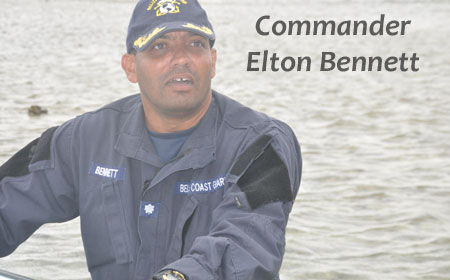GLOVERS REEF, Thurs. June 11, 2015–Just before midnight last night, Wednesday, the loud revving of a heavy engine overwhelmed the sound of the hard rains on Glovers Reef and shortly after the noise of the engine, a crashing sound alerted the park rangers and Fisheries Department staff who are stationed on the island that something had happened about 500 yards from where they are housed.
Following the crashing sound, powerful spotlights came from the direction of the reef, where a Guatemalan Navy boat had become beached. Frantic calls were made from Glovers Reef to the Belize Coast Guard, as another Guatemalan gunboat was observed in the immediate vicinity.
With the arrival of daylight, the large Guatemalan gunboat, with its heavy 105mm gun, could be seen parked on top of the reef.
The news of the Guatemalan Navy boat crashing onto Glovers Reef began making the rounds early this morning on social media.
Almost 24 hours after the incident that Belize Coast Guard Commander Elton Bennett today has characterized as an “accident,” the official channels of the relevant government ministries — Foreign Affairs, National Security, and the Department of the Environment, have not put out a press statement to reassure Belizeans that there is nothing sinister about the landing of the Guatemalan gunboat on top of our reef, and that the Republic of Guatemala will be held responsible for compensation for whatever damage their military vessel has caused to the reef.
Commander Bennett, who was deployed from Coast Guard Headquarters in Belize City, arrived at the scene at the first light of dawn.
Bennett told reporters this afternoon that when he arrived, he communicated with the Guatemalan captain of the vessel GC621 via a radio call, and after that initial communication, he determined that it was safe for him to board the vessel and take command of the situation.
The GC621, a 70-foot vessel on which 21 Guatemalan Navy cadets were travelling from Puerto Barrios, Guatemala, to Isla Mujeres, Mexico, was accompanied by another similar Guatemalan Navy vessel. After the accident, the other Guatemalan gunboat remained outside the reef, but apparently still inside Belize’s territorial waters.

Bennett confirmed with his Mexican counterparts that they were indeed expecting the two Guatemalan vessels.
In the early afternoon hours, a Belize Defence Force Air Wing Defender aircraft, a dubious name for an unarmed aircraft, could be seen making wide circles in the area above where the gunboat lay perched atop the reef.
Docked at the pier were two Boston Whalers, Belize Coast Guard vessels, but their tripods, designed for 50-caliber machine guns, the heaviest weapon in their arsenal, were empty. A number of Coast Guard personnel were on the island, however, with their various assault rifles.
A third Guatemalan Navy boat, a Columbian type vessel, was also observed in the vicinity of the grounded boat.
Bennett, who was onboard the Guatemalan navy boat and had to wade through water to meet with reporters, said that he was awaiting the arrival of a multi-agency team so that they could do an initial dive to determine what damage was done to the reef.
There are, however, conflicting reports of how the boat landed on the reef. The Chief Executive Officer in the Ministry of National Security, Col. George Lovell, (Ret.d), said early this morning that the boat experienced a propulsion problem. That does not square with the noise coming from the boat engine that those who are on the island heard.
Then Commander Bennett said that the Guatemalan captain told him that he had had steering problems.
Amandala sought clarity on these two differing explanations from Major Lloyd Jones, who was the Commanding Officer of the Belize Defence Force Maritime Wing for a number of years.
Major Jones told Amandala, “The pictures I am seeing on the news suggest to me that the vessel was moving forward when it went aground.”
As to the statement that the vessel had steering problems, Major Jones said, “Normally, when a vessel goes aground as a consequence of drifting, it does not go hard aground. The vessel is hard aground, suggesting it was under propulsion; in other words, the man deh drive right onto the reef.”
If it was a steering problem the vessel had, Major Jones said, “They would have had to drift for more than 12 nautical miles, with a rate of drift of less than 1 knot (1 nautical mile per hour), and it would have taken more than 12 hours for them to have run aground on the reef.” “If the vessels were travelling together, why did the good vessel not take the distressed vessel in tow and prevented it from grounding?” he asked.
In response to a question from KREM TV’s Marisol Amaya, as to why he (Bennett) took over six hours before reaching Glovers Reef, Bennett said that the Coast Guard had deployed another vessel from Calabash Caye.
That vessel, however, did not engage in any communication with the Guatemalans. And it was not until day was breaking, when Bennett arrived, that the Coast Guard began communicating with the Guatemalans onboard GC621.
Bennett said that if it is proven that there was negligence on the part of the Guatemalan captain, then he and his men would be detained and they would be dealt with according to the results of the examination that is being conducted by the various agencies involved.
We understand that a diplomatic note about the incident has been sent to the Guatemalan government.

